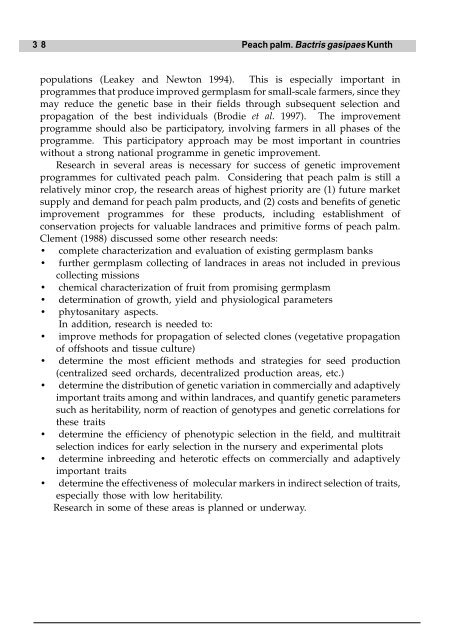Peach palm - World Agroforestry Centre
Peach palm - World Agroforestry Centre
Peach palm - World Agroforestry Centre
You also want an ePaper? Increase the reach of your titles
YUMPU automatically turns print PDFs into web optimized ePapers that Google loves.
3 8 <strong>Peach</strong> <strong>palm</strong>. Bactris gasipaes Kunth<br />
populations (Leakey and Newton 1994). This is especially important in<br />
programmes that produce improved germplasm for small-scale farmers, since they<br />
may reduce the genetic base in their fields through subsequent selection and<br />
propagation of the best individuals (Brodie et al. 1997). The improvement<br />
programme should also be participatory, involving farmers in all phases of the<br />
programme. This participatory approach may be most important in countries<br />
without a strong national programme in genetic improvement.<br />
Research in several areas is necessary for success of genetic improvement<br />
programmes for cultivated peach <strong>palm</strong>. Considering that peach <strong>palm</strong> is still a<br />
relatively minor crop, the research areas of highest priority are (1) future market<br />
supply and demand for peach <strong>palm</strong> products, and (2) costs and benefits of genetic<br />
improvement programmes for these products, including establishment of<br />
conservation projects for valuable landraces and primitive forms of peach <strong>palm</strong>.<br />
Clement (1988) discussed some other research needs:<br />
• complete characterization and evaluation of existing germplasm banks<br />
• further germplasm collecting of landraces in areas not included in previous<br />
collecting missions<br />
• chemical characterization of fruit from promising germplasm<br />
• determination of growth, yield and physiological parameters<br />
• phytosanitary aspects.<br />
In addition, research is needed to:<br />
• improve methods for propagation of selected clones (vegetative propagation<br />
of offshoots and tissue culture)<br />
• determine the most efficient methods and strategies for seed production<br />
(centralized seed orchards, decentralized production areas, etc.)<br />
• determine the distribution of genetic variation in commercially and adaptively<br />
important traits among and within landraces, and quantify genetic parameters<br />
such as heritability, norm of reaction of genotypes and genetic correlations for<br />
these traits<br />
• determine the efficiency of phenotypic selection in the field, and multitrait<br />
selection indices for early selection in the nursery and experimental plots<br />
• determine inbreeding and heterotic effects on commercially and adaptively<br />
important traits<br />
• determine the effectiveness of molecular markers in indirect selection of traits,<br />
especially those with low heritability.<br />
Research in some of these areas is planned or underway.

















